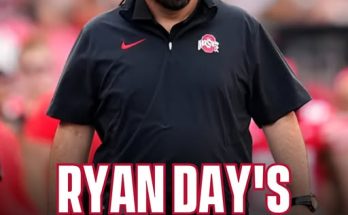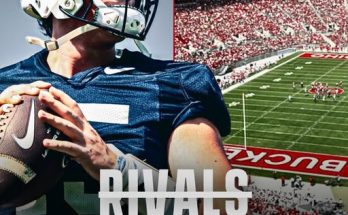The Arizona Cardinals find themselves in a unique and pivotal position heading into the 2025 NFL Draft. With a combination of high draft capital, an evolving roster, and a new era slowly taking shape under head coach Jonathan Gannon and general manager Monti Ossenfort, the franchise must now decide how aggressive it should be in shaping the future. Should the Cardinals leverage their assets and pounce boldly in the draft, or should they take a more calculated, long-term approach?
In today’s NFL, aggressiveness in the draft is often the hallmark of forward-thinking franchises. The Cardinals, who finished near the bottom of the league standings, own multiple first-round picks thanks to the trade that sent last year’s No. 3 overall pick to the Houston Texans. Those picks represent a golden opportunity to reshape the identity of a team that has been stuck in mediocrity for far too long. But being aggressive doesn’t just mean trading up for a quarterback or moving mountains to land a blue-chip star—it means taking a clear stance on the team’s direction and making bold decisions that reflect it.
At the center of Arizona’s draft strategy is the question of quarterback Kyler Murray. After tearing his ACL in December 2022 and returning to the field midway through the 2023 season, Murray showed flashes of his old self—but not consistently enough to erase doubts. The front office has expressed confidence in Murray, and trading him would come with massive financial implications. But if Arizona believes it is time to move on, then this year’s quarterback-heavy draft class gives them the perfect platform to reset. Drake Maye, Caleb Williams, Shedeur Sanders, and J.J. McCarthy all offer tantalizing potential. If Arizona has any doubts about Murray being the long-term answer, this is the moment to be aggressive.
However, if the Cardinals are committed to building around Murray, they still have plenty of reasons to be bold. For starters, the team has glaring needs across the roster, including at wide receiver, edge rusher, offensive line, and cornerback. If Arizona believes one of the top prospects—like Ohio State wideout Marvin Harrison Jr. or Alabama edge rusher Dallas Turner—can be a foundational piece, they must be willing to move decisively to get him. Standing pat may not be enough in a draft where other teams are also jockeying for position and elite talent is scarce beyond the top tier.
Marvin Harrison Jr., in particular, represents a dream scenario for the Cardinals. The son of a Hall of Famer, Harrison is widely regarded as one of the most polished receiver prospects in recent memory. He would give Murray the kind of true WR1 that he hasn’t consistently had since DeAndre Hopkins’ departure. Pairing Harrison with Murray could supercharge the offense and take pressure off the quarterback, who has often had to shoulder the load without elite weapons. But to get Harrison, the Cardinals may need to trade up—especially if another QB-needy team leapfrogs them in pursuit of a passer. This is where aggressiveness pays off. Do you wait and hope Harrison falls, or do you make your move and secure a generational talent?
Another reason to be aggressive is the broader competitive landscape in the NFC West. The San Francisco 49ers are perennial contenders with a stacked roster. The Los Angeles Rams, despite recent retooling, still boast Aaron Donald and a promising core. Even the Seahawks, now under new leadership, have remained competitive. The Cardinals can’t afford to lag behind. Playing it safe in the draft might keep the team afloat, but it won’t propel them into playoff contention. Aggressive drafting—whether it’s trading up for stars or stockpiling picks through savvy deals—can help them close the gap faster.
Historically, the Cardinals have not been a franchise known for swinging big in the draft. From Josh Rosen to Isaiah Simmons to Zaven Collins, many of their high picks have failed to fully pan out. This has led to a cautious front office approach in recent years. But Ossenfort’s arrival signaled a potential shift in philosophy. Last year, he executed a bold move down the board to gain future picks, then moved back up to grab Paris Johnson Jr.—an offensive lineman he believed could anchor the trenches for years to come. That kind of shrewd, aggressive maneuvering is exactly what the Cardinals need again this year.
There is also a psychological aspect to consider. The Cardinals have been a bottom-feeder franchise for most of the last decade. Fan interest has waned, and the culture of the organization has often been questioned. Making a splash in the draft—not just with who they pick, but how they go about it—can reinvigorate the fan base and re-establish Arizona as a team with ambition and direction. Drafting with urgency sends a message that the status quo is no longer acceptable.
On the flip side, recklessness masquerading as aggressiveness can be dangerous. Trading away too many future assets or over-drafting a player based on need rather than value can set the franchise back. The balance is delicate. The most successful aggressive teams—like the Eagles, Chiefs, and Bills—build through the draft with purpose, not panic. For the Cardinals, that means having a clear internal evaluation of where the roster stands and targeting prospects who fit their vision for both sides of the ball.
Defensively, the Cardinals were one of the worst units in the league last season, and that can’t be ignored. They need blue-chip talent on the defensive line, a top-tier cornerback to anchor the secondary, and reliable linebackers to solidify the middle of the field. This year’s draft class has depth on defense, especially in the edge rusher and cornerback groups. Players like Jared Verse, Laiatu Latu, and Kool-Aid McKinstry could be immediate impact guys. Being aggressive here doesn’t necessarily mean trading up—it could mean doubling down on defense with multiple top-50 picks and prioritizing foundational players over flashy names.
The offensive line is another area where the Cardinals could justify going bold. Paris Johnson Jr. was a strong addition, but the line as a whole still lacks depth and consistency. Drafting a plug-and-play guard or tackle early, even if it means reaching slightly, could pay off in spades by keeping Murray upright and the offense humming. Protecting the quarterback has to be a top priority, and aggressive drafting on the O-line is often less glamorous but just as impactful as grabbing skill players.
All this comes back to one fundamental truth: the Cardinals cannot afford to be passive. Whether they decide to bet big on a quarterback, go all-in for Marvin Harrison Jr., or overhaul the defense with a series of targeted picks, they must commit to a plan and pursue it with conviction. This isn’t the year to play it safe and hope for a surprise playoff push. It’s a time to lay the groundwork for sustainable success—and that requires bold moves.
The draft is also a statement of belief. Do the Cardinals believe in Kyler Murray as their franchise quarterback? Do they believe their rebuild is closer to the finish line than the starting block? Do they believe they can compete with the 49ers, Rams, and Seahawks in the near future? Their actions on draft night will answer all of these questions.
If Ossenfort and Gannon truly want to change the course of this franchise, now is the time. Aggressiveness doesn’t mean carelessness—it means knowing what you want and going after it with precision. The Cardinals have the capital. They have the need. And they have the chance. The question is: do they have the guts?
There are no guarantees in the NFL Draft. Every pick is a risk, every trade a gamble. But the teams that make the leap from rebuilding to contending are often the ones willing to bet on their evaluations and take calculated risks. For the Arizona Cardinals, the 2025 NFL Draft is more than just a chance to add talent. It’s a chance to change their story.
They shouldn’t let it slip by.



